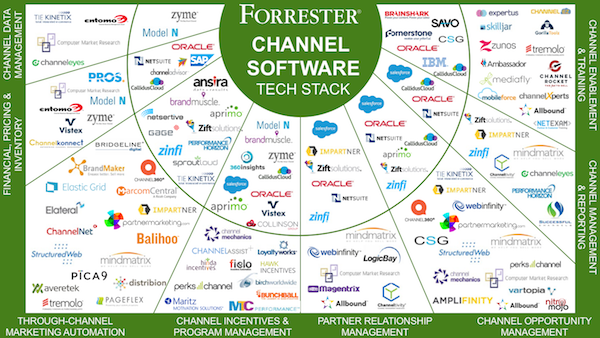I love the channel software landscape graphic below produced by Jay McBain of Forrester. It’s accompanied by a fantastic article, The Channel Software Stack – A Comprehensive (And Critical) Look At The Future Of The Industry that I highly recommend reading.
There’s a whole cottage industry of technology landscapes with little logos out there. (And who am I to throw stones?) Heck, there’s even a software solution for making logo landscapes of other software solutions — Logo Intern — which could get really meta if you were to map out all of their competitors with it.
There are easily hundreds if not thousands of different technology landscape graphics just a Google search away. While some might consider that a bizarre techno-fetish (logo-fetish?) cultural hiccup, I think it’s simply an artifact of software eating the world.
At some level, all these different blossoming landscapes signal something remarkable: the explosion of software companies and broad interest in them in almost every profession, industry, and technology sector in the world. Love ’em or hate ’em, these landscapes are collectively a reflection of our reality.
Jay made the following statement in his post that I want to highlight in big letters:
I estimate there are more than 100,000 software companies (ISVs) today around the world — up from 10,000 only 10 years ago.
I wouldn’t be surprised, with the level of hyperspecialization new buyers are demanding, to see that number grow to 1 million by 2027.
One million software companies.
That might sound astounding at first. But when you think about it, it’s actually pretty logical. In an ever-more-digital world — and I do believe that the digitalization of life as we know it is still in its earliest stages — a lot of companies are going to be software companies. Everything digital is run by software.
And while there will certainly be giants, like the current Frightful Five — Amazon, Apple, Facebook, Google, and Microsoft — I’m skeptical that the world will condense down to half a dozen mega-corps and nothing else.
(Although the irony of Apple becoming its own 1984 nightmare in the span of 30 years is a fascinating narrative.)
Agility and innovation favor start-ups. They always have.
The two ends of that spectrum are not necessarily incompatible. You can have a small number of giants and a plethora of smaller start-ups and specialists. In fact, as Joseph Flaherty recently argued in an article on TechCrunch pushing back on the supposed end of the startup era:
“If we define startup success as building cornerstone companies that will go down in history and be worth hundreds of billions of dollars, we may, in fact, be entering a lean period. If we define success as building an ever wider assortment of products, shipping them to tens of millions of users and earning hundreds of millions, or even billions of dollars in short time frames, the good times may just be getting started.”
In many ways, large “market makers” who offer stable platforms can catalyze the perfect environment for an ecosystem of entrepreneurs to thrive. (That’s one of the reasons I’m so passionate about the role I took at HubSpot earlier this fall.)
Joseph demonstrated this across several other industry examples:
“The kind of industry consolidation we see with the ‘Frightful Five’ isn’t new to tech, it’s the norm in most industries and can actually spur innovation. The pharmaceutical and packaged food industries are heavily consolidated, have thriving startup scenes, are hyperactive in M&A and provide a glimpse of how the future of tech may unfold.”
Entrepreneurs may have to settle for acquiring mere generational wealth, rather than becoming ‘pledge to cure all diseases’ wealthy, but the death of startups has been greatly exaggerated.
Which brings me back to Jay’s article on the channel software stack.
“Platform winners have now emerged across each [line of business],” he writes. “This has created the next battleground — competing within these ecosystems for horizontal and vertical technology opportunity. Firms are increasingly achieving business outcomes by stitching together several ISV solutions on top of the business application platform.”
Of course, there will be consolidation. The larger fish will eat smaller fish — this is a necessary dynamic for them to acquire the fruits of small-firm agility and innovation. But, as in nature, the population of small fish keeps rejuvenating.
This is exactly what happened with the marketing technology landscape from 2010 to 2017. 61% of the martech companies I found in 2010 were acquired over the past 7 years — many serving as key components in today’s major “marketing clouds.”
But that didn’t stop the explosion of 5,000 marketing technologies from arising at the same time. Consolidation can actually be a phenomenal catalyst for entrepreneurship.
So hats off to both Jay and Joseph for looking beyond the headlines of the big acquisitions to recognize that all those little logos on all these crazy landscapes actually have important roles to play — and that narrative is arguably much more exciting and full of possibilities than the tired cry of “Consolidation!”
The cry “One Million!” is a much more future-forward outlook.






Hi Scott.
Great article. The Frightful Five should be enlarged to be the Awful Eight and include Alibaba, Tencent and Baidu. These guys in Asia are going to fast eclipse many of the North American centric players. If you look at China alone, the number of software players there would easily account for the growth targets Forrester predict.
Excellent point. But I think we need full alliteration, no? The Enviable Eight? Enduring Eight? Encompassing Eight? Endless Eight?
Entrenched Eight
You know Scott, after our conversations about logo landscapes over the past few days – I’m going to need to play with Logo Intern now.
I happen to have a folder with 200 logos from a certain industry in it.
Why is not there any RPA vendor? Blue prism, Automation Anywhere, Uipath